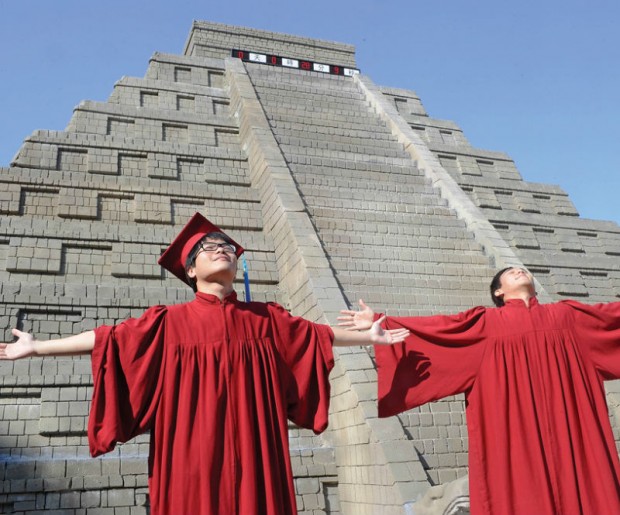Guatemala’s Mayan heritage lives on in spicy pepian

ENDGAME. Students celebrate their graduation—alive and well—in front of a replica of a Mayan pyramid in Mexico before a countdown ceremony to assure people it is not the end of the world. AFP
GUATEMALA CITY, Guatemala—The smells of a bygone era waft through the air as Elsa Morales tosses an ancient Mayan spice on her sizzling grill to make a batch of pepian stew.
The meaty dish is an explosion of flavors that combines tastes from the New World and the Old—the history of Guatemala on a plate, but with less bitterness and more spice.
Pepian blends foods brought from Europe by the Spanish conquistadors, like onion, sesame, cinnamon, and coriander, with the key ingredient: an indigenous spice called pepitoria, made by roasting and grinding the seeds of a native squash.
The dish is a cultural cornerstone in Guatemala, despite the impoverished Central American country’s sometimes uneasy relationship with its Mayan heritage.
Guatemalans’ passion for pepian is so intense that the government declared the dish part of it national heritage in 2007.
Article continues after this advertisementPepian has a thick, deep-red sauce made of tomatoes, garlic and chilis, dotted with chunks of meat, carrots and potatoes.
Article continues after this advertisementSpicy but not tongue-numbing, it is typically served over rice, and is savored by Guatemalans of all walks of life.
‘Rare cultural victory’
Morales has served several presidents at her diner, Rosita, which is located in a basement in the market at the heart of Guatemala City’s historic center.
“Once they come, they always come back,” said the 62-year-old chef.
Historians say pepian originated among the Maya-Kaqchikel ethnic group in the western region of Chimaltenango before Europeans arrived in the Americas.
“In the pre-Hispanic world, pepian was served at major religious and political ceremonies and rituals. So indigenous groups continued the tradition and pepian became Guatemala’s quintessential ceremonial dish,” said Ericka Sagastume, an expert on Guatemalan cuisine at the Center for Folkloric Studies at the University of San Carlos.
Originally, the dish was made of pepitoria, chilis and tomatoes, she told AFP.
Over time, the recipe shifted to incorporate ingredients brought from Europe.
But pepitoria has remained the key component—a rare cultural victory for Guatemala’s indigenous peoples, who have endured five centuries of Spanish conquest, colonial subjugation and marginalization under successive post-independence governments, and were the main victims of Guatemala’s 1960 to 1996 civil war, which killed some 200,000 people in this country of 15 million.
Today, indigenous Guatemalans make up about 40 percent of the population, according to census figures.
The other 60 percent identify as “ladino,” the Guatemalan term for people of European or mixed descent—the group that has dominated Guatemala’s politics and economy since colonial times.
Past and present
Despite being pushed to the edges of Guatemalan society, the country’s Mayan peoples have left a subtle imprint on the national culture.
“Every day we see different cultural contributions to our daily life, particularly from indigenous peoples,” said the anthropologist Ervin Us.
He cited a tradition of community-based decision-making and “collective prayer,” which endures although the population today is overwhelmingly Catholic and Protestant.
“The idea of understanding the supernatural is something deeply anchored in the indigenous population,” he said.
Other signs of indigenous influence include prized indigenous paintings from Chimaltenango and the nearby region of Solola, the corn tortillas that are even more ubiquitous than pepian, and the colorful clothing, bags and fabrics that are the hallmarks of Guatemala’s markets.
“Even if there’s a push to deny the country’s indigenous past, the proof of (this influence) is so strong that it extends even to fashion,” said Us.
RELATED STORIES
World greets Mayan ‘doomsday’ with pinch of salt